
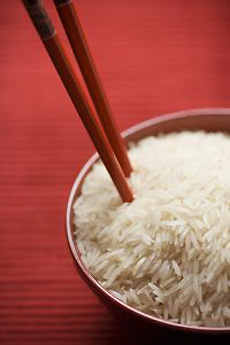
Basmati rice, a long-grain cultivar from India known for its fragrance and subtle flavor, has been discovered in recent years by American chefs. Photo by Brandon W. Mosley | SXC.
October 2007
Updated July 2008
|
 |
Rice: History & Types Of Rice
Page 1d: How To Grow Rice
CAPSULE REPORT: Learn all about rice, how it is cultivated and the many different types of rice in this comprehensive review. Click on the black links below to visit other pages of the article.
How To Grow Rice
|
The two major types of rice, indica (long-grain) and japonica (medium- and short-grain) do well in different environments. Long-grain indica rices (basmati and jasmine, for example) do well in hot, equatorial climates. Medium- and short-grain japonica rices grow well in temperate and mountainous regions. Rice cultivation has traditionally been well-suited to countries and regions with low labor costs and high rainfall. Without modern technology, rice is very labor-intensive to cultivate; either way it requires plenty of water for irrigation.
|
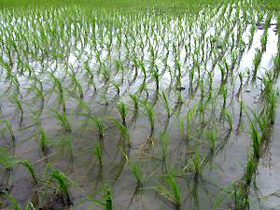
Seedlings in a rice paddy. Photo by Kashfia Rahman | SXC. |
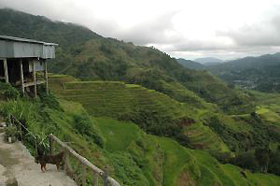 Farmers working in a paddy in Bangladesh. Photo
Farmers working in a paddy in Bangladesh. Photo
by Shahnur A. Alam | SXC.
|
Rice can be grown practically anywhere, even on steep hillsides. It is typically grown in paddies, shallow puddles, because the the rice plant is tolerant of water and the water in the paddies prevents weeds from overtaking the seedlings. Once the crop is grown, the water is drained so it can be harvested. While the paddy system increases productivity, rice can also be grown on dry land; for example, on terraced hillsides in areas lacking flat lands, with the help of chemical weed controls. Paddies are dug into some terraces.
|
Planting
Paddies, standing puddles of water, are an inspired form of agriculture. First, they conserve a limited supply of water, as opposed to farming that requires constant irrigation. One- to six-week-old seedlings are transplanted into the water, giving the young plants an important head start to survive over a very wide range of competing weeds. While some weeds grow in water, there are far fewer there than on land. Thus, paddy cultivation leads to higher yields. Transplanting seedlings lets the farmer adjust the planting calendar to accommodate the water supply and other variables.
In small, non-mechanized operations, rice seedlings are hand-planted in paddies (“wet rice cultivation”) using traditions honed over millennia—it is back-breaking work. Fields are sometimes drained temporarily for fertilizing and weeding.
While paddies are generally just a few inches deep, different methods of rice cultivation have evolved in different regions to meet specific climate and geography challenges. For example, in flood-prone Bangladesh, “deep-water rice” is grown by seeding the rice just as the water is just beginning to rise; the growth of plants keeps up with the rising water level. The rice plants bear their grain above the surface of the water, sometimes to depths of five meters!
On mega-farms in California, Texas and elsewhere, each March the rice fields are carefully leveled with laser-precision grading equipment (because flat land conserves water); tractors plow shallow furrows into the field, the water is run in to a depth of five inches, and airplanes flying at 100 mph sow the rice seeds from the air.
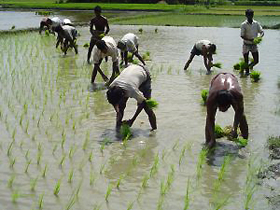 Old-style rice farming: Farmers working in a paddy in Bangladesh, planting seedlings as they’ve done for millennia. Photo by Shahnur A. Alam | SXC
Old-style rice farming: Farmers working in a paddy in Bangladesh, planting seedlings as they’ve done for millennia. Photo by Shahnur A. Alam | SXC |
|
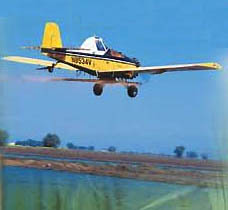
New-style rice farming: Seeding a rice field by plane in California’s Sacramento Valley. Photo courtesy of CalRice.org.
|
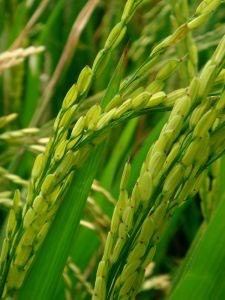
Grains of rice grow in panicles at the top of the plant. Photo by S.R. Patel | SXC. |
Whether by old school or new school technique, the rice grows. As the seedlings mature, they draw nutrients from the paddy water. The same water keeps the weed population under control.†
Over the four to five months that the rice matures, the paddies change from green to golden yellow to the color of dry straw. When the seedlings will reach maturity, the stalks will be three feet tall and grains of rice will be dangling in their husks, from long panicles at the top of the plant.
†Applications of herbicides are applied to control weeds, and if necessary, farmers may also treat the fields for the rice water weevil and other insects. There are also organic rices, grown with no chemical pesticides.
|
Harvesting & Milling
Grains are harvested before they are fully mature, about 30 days after the rice plants have flowered. The levees are opened and the water is drained. The plants are cut halfway up the stem. In non-mechanized farming they are hand-harvested by sickle. In the U.S., where the rice industry is thoroughly mechanized, a giant combine harvester rolls across the field, cutting the plants and separating the rough or paddy rice from the straw. The rice can be allowed to dry in the field or bundled for processing. Here, the rough rice is transported to enormous dryers where the moisture content is reduced to an ideal level. The rice is now ready for milling. On average, one acre in a modern rice field yields 8,000 pounds of rice!
The milling process in the U.S. is high tech and efficient, but very simple. In this country, white rice is converted or parboiled to retain nutrients. In this process, it is steam pressure-treated before it is hulled; the steam forces some of the nutrients from the hull into the grain. The hull is then removed in a sheller, basically two rubber rollers that remove the hulls by friction.
The rice that first emerges is brown rice—it still is covered by the bran. To get white rice, the bran is removed by abrasion, rubbing the grains against each other. Broken grains are sorted out by sifting through a series of screens—the most high-tech mills have a laser scanner that spots discolored kernels and blasts them aside with pressurized air. The beautiful rice is now ready to be packaged and sold.
In the absence of technology, the harvested grains are threshed to separate the grain from the stalk and the enclosing husk. This is usually done by bashing bundles of rice stems on a stone or other hard platform, or by using animals to trample on the stems. Winnowing is usually done by shaking or tossing the rice on a basketwork tray. The grain falls onto the mat and the husk, chaff and dust are carried away by the wind. Luckier people have hand-winnowing machines. The grain is then dried in the sun, until it is ready for hulling or transport to the mill.
Now that you know the background of rice, you can view the many varieties of rice.
Continue To Page 2: Different Types Of Rice
Go To The Article Index Above

|









